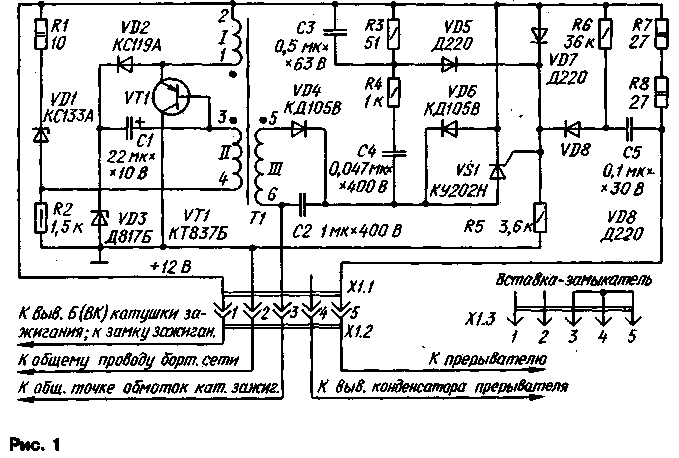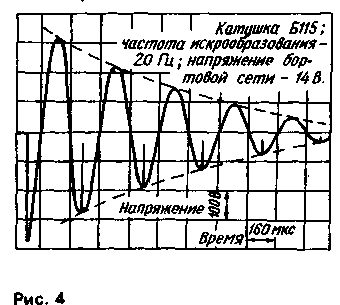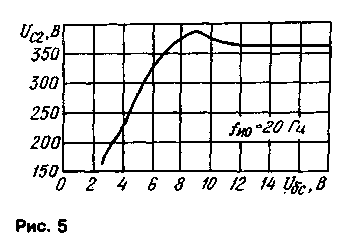
|
|
ENCYCLOPEDIA OF RADIO ELECTRONICS AND ELECTRICAL ENGINEERING Improved ignition unit. Encyclopedia of radio electronics and electrical engineering
Encyclopedia of radio electronics and electrical engineering /Automobile. Ignition This design can be recommended to trained radio amateurs who already have experience in manufacturing simple ignition blocks and who want to have a device from which, figuratively speaking, everything that seems possible today is “squeezed out”. Over the past years, the stabilized ignition unit [1] was repeated by many car and radio amateurs, and despite the shortcomings identified, we can assume that it has withstood the test of time. It is also significant that no publications of structures similar in simplicity with similar parameters have yet appeared in the literature. These circumstances prompted the author to make another attempt to fundamentally improve the performance of the block, while maintaining its simplicity. The main difference between the improved ignition unit and [1] is a noticeable improvement in its energy characteristics. If for the original block the maximum spark duration did not exceed 1,2 ms, and it could be obtained only at the lowest values of the sparking frequency, then for the new one, the spark duration is constant in the entire operating band of 5 ... 200 Hz and is equal to 1,2 .. .1,4 ms. This means that at medium and maximum engine speeds - and these are the most commonly used modes - the duration of the spark practically corresponds to the requirements that are currently established. The power supplied to the ignition coil has also changed significantly. At a frequency of 20 Hz with a B-115 coil, it reaches 50 ... 52 mJ, and at 200 Hz - about 16 mJ. The limits of the supply voltage within which the unit is operable have also been expanded. Confident sparking when starting the engine is ensured at an onboard voltage of 3,5 V, but the unit remains operational even at 2,5 V. At the maximum frequency, sparking is not disturbed if the supply voltage reaches 6 V and the spark duration is not less than 0,5 ms. . These results were obtained mainly by changing the operating mode of the converter, especially the conditions of its excitation. These indicators, which, according to the author, are at the practical limit of possibilities when using only one transistor, are also ensured by the use of a ferrite magnetic circuit in the converter transformer. As can be seen from the block diagram shown in Fig. 1, its main changes relate to the converter, i.e. charge pulse generator that feeds the storage capacitor C2. The circuit for starting the converter is simplified, which, as before, is made according to the scheme of a single-cycle stabilized blocking generator. The functions of the starting and discharge diodes (respectively VD3 and VD9 according to the previous scheme) are now performed by one zener diode VD1. This solution provides a more reliable start of the generator after each sparking cycle by significantly increasing the initial bias at the emitter junction of the transistor VT1. Nevertheless, this did not reduce the overall reliability of the block, since the transistor mode did not exceed the permissible values in any of the parameters. The charging circuit of the delay capacitor C1 has also been changed. Now, after charging the storage capacitor, it is charged through the resistor R1 and the zener diodes VD1 and V03. Thus, two zener diodes are involved in stabilization, the total voltage of which, when they are opened, determines the voltage level on the storage capacitor C2. Some increase in voltage on this capacitor is compensated by a corresponding increase in the number of turns of the base winding II of the transformer. The average voltage level on the storage capacitor is reduced to 345...365 V, which increases the overall reliability of the unit and at the same time provides the required spark power. In the discharge circuit of the capacitor C1, a stabistor VD2 is used, which makes it possible to obtain the same degree of overcompensation with a decrease in the on-board voltage, as three or four conventional series diodes. When this capacitor is discharged, the zener diode VD1 is open in the forward direction (like the diode VD9 of the original unit). Capacitor C3 provides an increase in the duration and power of the pulse that opens the trinistor VS1. This is especially necessary at a high sparking frequency, when the average voltage level across capacitor C2 is significantly reduced. In electronic ignition units with multiple discharges of the storage capacitor to the ignition coil [1,2, XNUMX], the duration of the spark and, to a certain extent, its power determines the quality of the trinistor, since all oscillation periods, except for the first one, are created and maintained only by the storage energy. The lower the energy consumption for each inclusion of the trinistor, the greater the number of starts will be possible and the greater the amount of energy (and over a longer time) will be transferred to the ignition coil. Therefore, it is highly desirable to select a trinistor with a minimum opening current. A trinistor can be considered good if the block provides the start of sparking (with a frequency of 1 ... 2 Hz) when the block is powered by a voltage of 3 V. Satisfactory quality corresponds to operation at a voltage of 4 ... 5 V. With a good trinistor, the spark duration is 1,3. ..1,5 ms, in case of bad - decreases to 1...1,2ms. In this case, however strange it may seem, the spark power in both cases will be approximately the same due to the limited power of the converter. In the case of a longer duration, the storage capacitor is discharged almost completely, the initial (aka average) voltage level on the capacitor, set by the converter, is somewhat lower than in the case with a shorter duration. With a shorter duration, the initial level is higher, but the residual voltage level on the capacitor is also high due to its incomplete discharge. Thus, the difference between the initial and final voltage levels on the storage device is practically the same in both cases, and the amount of energy introduced into the ignition coil depends on it [8]. And yet, with a longer spark duration, a better afterburning of the combustible mixture in the engine cylinders is achieved, i.e. increases its efficiency. During normal operation of the unit, the formation of each spark corresponds to 4,5 periods of oscillation in the ignition coil. It means. that the spark is nine alternating discharges in the spark plug, continuously following one after the other. Therefore, one cannot agree with the opinion (expounded in [4]) that the contribution of the third and even more so the fourth periods of oscillations cannot be detected under any conditions. In fact, each period makes its own very specific and tangible contribution to the total energy of the spark, which is also confirmed by other publications, for example [2]. However, if the on-board voltage source is connected in series with the circuit elements (i.e., in series with the ignition coil and storage), the strong attenuation introduced by the source, and not by other elements, really does not make it possible to detect the contribution mentioned above. Just such an inclusion was used in [4]. In the block being described, the onboard voltage source does not take part in the oscillatory process and, of course, does not introduce the mentioned losses. One of the most critical units of the block is the T1 transformer. Its magnetic circuit Sh15x12 is made of NM2000 oxyfer. Winding 1 contains 52 turns of wire PEV-2 0,8; 11-90 turns of wire PEV-2 0,25; III - 450 turns of wire PEV-2 0,25. The gap between the W-shaped parts of the magnetic circuit must be maintained with the greatest possible accuracy. To do this, during assembly, between its extreme rods, they are placed without glue along a getinax (or textolite) gasket with a thickness of 1,2 + 0,05 mm, after which the parts of the magnetic circuit are pulled together with strong threads. Outside, the transformer must be covered with several layers of epoxy, nitro-glue or nitro-enamel. The coil can be made on a rectangular spool without cheeks. Winding III is wound first, in which each layer is separated from the next with a thin insulating gasket, and completed with a three-layer gasket. Next, winding II is wound. Winding 1 is separated from the previous one by two layers of insulation. The extreme turns of each layer when winding on a spool should be fixed with any nitro glue. Flexible coil leads are best done at the end of the entire winding. The ends of the windings 1 and II should be drawn in the direction diametrically opposite to the ends of the winding Y1, but all the leads should be on one of the ends of the coil. In the same order, flexible leads are also placed, which are fixed with threads and glue on a gasket made of electric cardboard (pressboard). Before pouring, the conclusions are marked. In addition to KU202N, the KU221 trinistor with letter indices A-G can be used in the block. When choosing a trinistor, it should be taken into account that, as experience shows, KU202N compared to KU221 in most cases have a lower opening current, but are more critical to the parameters of the trigger pulse (duration and frequency). Therefore, for the case of using a trinistor from the KU221 series, the values \u3b\u0,25bof the elements of the spark extension circuit must be adjusted - the capacitor C4 must have a capacitance of 620 microfarads, and the resistor, RXNUMX, must have a resistance of XNUMX ohms. The KT837 transistor can be with any letter indices, except for Zh, I, K, T, U, F. It is desirable that the static current transfer coefficient is not less than 40. The use of a transistor of another type is undesirable. The heat sink of the transistor must have a usable area of at least 250 cm2. As a heat sink, it is convenient to use the metal casing of the block or its base, which should be supplemented with cooling fins. The casing must also provide splash protection for the unit. The VD3 zener diode must also be installed on the heat sink. In the block, it consists of two strips 60x25x2 mm in size, bent in a U-shape and nested one inside the other. The D817B zener diode can be replaced by a series circuit of two DV16V zener diodes; with an onboard voltage of 14 V and a sparking frequency of 20 Hz, this pair should provide a voltage of 350 ... .360 V on the drive. Each of them is installed on a small heat sink. Zener diodes are selected only after the selection and installation of the trinistor. The zener diode VD1 does not require a selection, but it must be in a metal case. To increase the overall reliability of the block, it is advisable to provide this zener diode with a small heat sink in the form of a crimp from a strip of thin duralumin. The stabistor KS119A (VD2) can be replaced with three D223A dyads (or other silicon diodes with a pulsed direct volume of at least 0,5 A) connected in series. Most of the block parts are mounted on a printed circuit board made of foil fiberglass with a thickness of 1,5 mm. The drawing of the board is shown in Fig.2. The board is designed taking into account the possibility of mounting parts with various replacement options. For a block designed to operate in areas with a harsh winter climate, it is advisable to use a tantalum oxide capacitor C1 with an operating voltage of at least 10 V. It is installed instead of a large jumper on the board, while the connection points of the aluminum oxide capacitor (it is shown on the board) , suitable for operation in the vast majority of climatic zones, should be closed with a jumper of the appropriate length. Capacitor C2 - MBGO.MBGCH or K73-17 for a voltage of 400 ... 600 V. In case of choice for a trinistor unit from the KU221 series the lower part of the board in Fig. 2 needs to be adjusted as shown in Fig.3. When mounting the trinistor, it is necessary to isolate one of the screws of its fastening from the printed track of the common wire, The performance check, and even more so the adjustment, should be carried out with just such an ignition coil with which the unit will work in the future. It should be borne in mind that turning on the unit without an ignition coil loaded with a glow plug is completely unacceptable. To check, it is quite enough to measure the voltage across the storage capacitor C2 with a peak voltmeter. An avometer with a constant voltage limit of 500 V can serve as such a voltmeter. The avometer is connected to capacitor C2 through a D226B diode (or similar), and the avometer clamps are shunted with a capacitor with a capacity of 0,1 ... 0,5 μF for a voltage of 400 ... 600 V . With a nominal supply voltage (14 V) and a sparking frequency of 20 Hz, the voltage on the drive should be in the range of 345 ... 365 V. If the voltage is less, then first of all select the trinistor, taking into account the above. If, after the selection, sparking is ensured when the supply voltage is reduced to 3 V, but there is an increased voltage on the capacitor C2 at the nominal lithium voltage, a VD3 zener diode with a slightly lower stabilization voltage should be selected. Next, the block is checked at the highest sparking frequency (200 Hz), maintaining the nominal on-board voltage. The voltage on the capacitor C2 should be in the range of 185 ... 200 V, and the current consumed by the unit after continuous operation for 15 ... 20 minutes should not exceed 2,2 A. If the transistor during this time heats up above 60 ° C at room ambient temperature, the heat dissipating surface should be slightly increased.
Capacitor C3 and resistor R4 are generally not required. However, for individual instances of SCRs (of both types) it may be necessary to adjust the ratings if instability in sparking is detected at a frequency of 200 Hz. It usually manifests itself in the form of a short-term failure in the readings of a voltmeter connected to the drive, and is clearly noticeable by ear. In this case, you should increase the capacitance of the capacitor C3 by 0,1 ... 0,2 μF, and if this does not help, return to the previous value and increase the resistance of the resistor R4 by 100 ... 200 Ohms. One of these measures, and sometimes both together, usually eliminates launch instability. Note that an increase in resistance decreases and an increase in capacitance increases the duration of the spark. If it is possible to use an oscilloscope, then it is useful to verify the normal course of the oscillatory process in the ignition coil and its actual duration. Until complete attenuation, 9-11 half-waves should be clearly distinguishable, the total duration of which should be equal to 1,3 ... 1,5 ms at any sparking frequency. The X input of the oscilloscope should be connected to the common point of the ignition coil windings. A typical view of the oscillogram is shown in Fig.4. Bursts in the middle of the negative half-waves correspond to single pulses of the blocking generator when the direction of the current in the ignition coil changes. It is also advisable to check the dependence of the voltage on the storage capacitor on the onboard voltage. Its appearance should not noticeably differ from that shown in Fig.5. The manufactured block is recommended to be installed in the engine compartment in the front, cooler part of it. The spark suppression capacitor of the interrupter should be disconnected and its output connected to the corresponding contact of the X1 socket socket. The transition to the classic ignition is carried out, as in the previous design, by installing the X1.3 contact insert. In conclusion, we note that attempts to obtain an equally "long" spark with a transformer on a steel magnetic circuit, even from steel of the highest quality, will not lead to success. The longest duration that can be achieved is 0,8...0,85 ms. Nevertheless, the unit is almost unchanged (the resistance of the resistor R1 should be reduced to 6...80 m) and is operable with a steel magnetic core transformer with the specified winding characteristics, and the performance of the unit is higher than that of its prototype [1]. Literature
Author: G. Karasev St. Petersburg; Publication: N. Bolshakov, rf.atnn.ru
Air trap for insects
01.05.2024 The threat of space debris to the Earth's magnetic field
01.05.2024 Solidification of bulk substances
30.04.2024
▪ Excess weight harms memory and learning ability ▪ SAMSUNG: hard drives have no future
▪ site section Indicators, sensors, detectors. Article selection ▪ article Blessing of the air. Popular expression ▪ article Confectioner. Standard instruction on labor protection ▪ article Fragrant pillows. Simple recipes and tips
Comments on the article: Yaroslav Great electronic ignition!
Home page | Library | Articles | Website map | Site Reviews www.diagram.com.ua |






 Arabic
Arabic Bengali
Bengali Chinese
Chinese English
English French
French German
German Hebrew
Hebrew Hindi
Hindi Italian
Italian Japanese
Japanese Korean
Korean Malay
Malay Polish
Polish Portuguese
Portuguese Spanish
Spanish Turkish
Turkish Ukrainian
Ukrainian Vietnamese
Vietnamese



 Leave your comment on this article:
Leave your comment on this article: